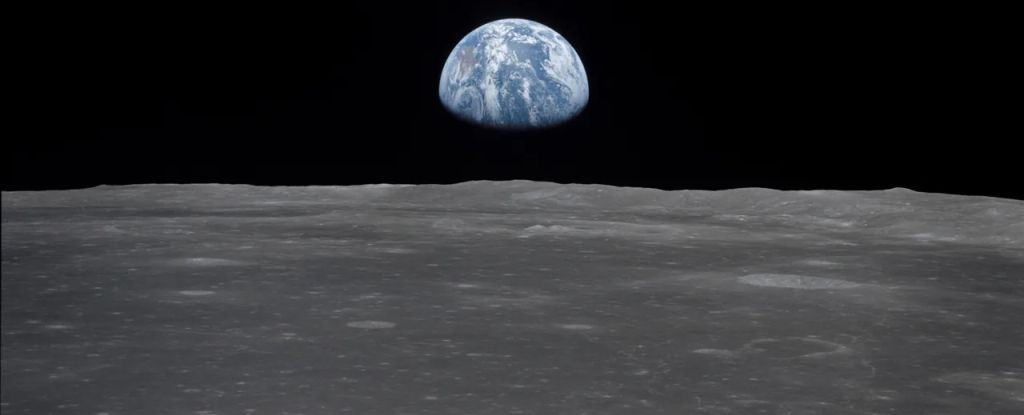The Moon, for most intents and purposes, is naked, bare, and exposed to the vacuum of space.
But Earth’s satellite does indeed have a blanket of gasses; thin and tenuous, but persistent enough to be considered a kind of atmosphere called an exosphere.
Exactly how the Moon sustains that diffuse shell of gasses has been something of a puzzle. Earth’s magnetic field acts as a confining influence its atmosphere, but the Moon has nothing of the sort, so its exosphere should have been stripped away by solar activity long ago.
It’s clear the Moon’s deplenishing gasses are constantly being topped up, and now scientists have discovered the source of that replenishment. Tiny micrometeorites, barely the size of grains of dust, are constantly smacking into the lunar surface, kicking up and vaporizing lunar dust, and releasing atoms into the space around the Moon.
“We give a definitive answer that meteorite impact vaporization is the dominant process that creates the lunar atmosphere,” says geochemist Nicole Nie of the Massachusetts Institute of Technology (MIT).
“The Moon is close to 4.5 billion years old, and through that time the surface has been continuously bombarded by meteorites. We show that eventually, a thin atmosphere reaches a steady state because it’s being continuously replenished by small impacts all over the Moon.”
Because the atmosphere of the Moon is so diffuse, it’s challenging to study. We know it is there because detectors left by the Apollo missions have detected different atomic components therein, but scientists have had a hard time figuring out exactly how it originates.
Micrometeorite impacts have been strongly implicated as a major contributor through modeling, as has a process called ‘ion sputtering‘ in which atoms are ejected from the lunar surface when bombarded with charged particles carried by the solar wind.
Nie and her colleagues wanted to look more closely at these different processes and the role they play in generating and maintaining the lunar exosphere, so they performed a new analysis. They carefully studied data from a lunar orbiter called the Lunar Atmosphere and Dust Environment Explorer (LADEE), which operated for seven months between 2013 and 2014.
“Based on LADEE’s data, it seemed both processes are playing a role,” Nie says. “For instance, it showed that during meteorite showers, you see more atoms in the atmosphere, meaning impacts have an effect. But it also showed that when the Moon is shielded from the Sun, such as during an eclipse, there are also changes in the atmosphere’s atoms, meaning the Sun also has an impact. So, the results were not clear or quantitative.”
In order to narrow it down further, the researchers needed to go right to the source. They examined actual samples of Moon dirt, collected during the Apollo program, looking for two elements: potassium and rubidium, both known to occur on the Moon, and both easily vaporized.
When solar particles or micrometeorites smack into the lunar surface, any rubidium and potassium hanging out there would be vaporized. Being heavier elements, however, they would fall back down to the lunar surface pretty quickly.
Crucially, the ratios of each element’s isotope rain would vary depending on whether they were vaporized by micrometeorite impact or ion sputtering.
The team crushed their Moon dirt to a fine powder and analyzed the results using a mass spectrometer. And they found that both processes are indeed playing a role in generating the lunar exosphere – but the contribution of micrometeorites is more than double the contribution of the solar wind.
“With impact vaporization, most of the atoms would stay in the lunar atmosphere, whereas with ion sputtering, a lot of atoms would be ejected into space,” Nie explains. “From our study, we now can quantify the role of both processes, to say that the relative contribution of impact vaporization versus ion sputtering is about 70:30 or larger.”
This result doesn’t just have implications for our understanding of the Moon. If similar processes are taking place elsewhere in the Solar System, such as asteroids and other moons, we could detect them in samples.
Missions to retrieve those samples have already been performed, or are underway. The European Space Agency is hoping to send a sample return mission to Martian moon Phobos, for example.
“Measuring potassium and rubidium isotopes in the regolith of those objects,” the researchers write, “will help us understand how they were affected by meteoroid bombardments and solar wind sputtering on geological timescales and how space weathering differs across the Solar System.”
The findings have been published in Science Advances.





